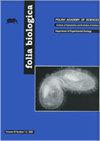小马蹄蝙蝠种群(波兰南部)回声定位叫声的静息频率及其与体型、状况和质量的关系
IF 0.8
4区 生物学
Q4 BIOLOGY
引用次数: 0
摘要
静止蝙蝠发出的回声定位叫声以其静息频率(RF)为特征。RF的生态作用在有关犀科的文献中得到了广泛讨论,研究发现RF可能因许多因素而变化,尽管它在塑造不同种群变异性方面的作用尚不清楚,而且包括犀在内的许多物种的数据也很少。在这项研究中,我们的目的是确定性别、年龄和生物特征参数(体重、前臂长度和身体状况指数)如何影响R.hipopsideros种群的RF,并调查该参数的个体变异性。交配季节,蝙蝠在波兰南部喀尔巴阡山脉的两个洞穴前被捕获。记录了手持蝙蝠的回声定位叫声,后来用计算机软件测量了它们的峰值频率。分析显示,女性的RF值高于男性,但(与之前的报告相反)没有发现年龄组之间的差异。RF与研究人群中的任何生物特征参数都不相关,这排除了通过该参数发出质量特征信号的可能性。然而,我们观察到性别年龄组的RF存在显著的个体差异,这可能反映了一些沟通潜力。该主题的研究结果之间的差异表明,需要进一步研究RF的变异性及其在物种分布范围内的作用及其酚学。本文章由计算机程序翻译,如有差异,请以英文原文为准。
Resting Frequency of Echolocation Calls within a Lesser Horseshoe Bat Population (Southern Poland) and its Relation to Body Size, Condition and Mass
The echolocation calls emitted by stationary bats are characterised by their resting frequency (RF). The ecological role of RF has been widely discussed across the literature concerning the Rhinolophidae family, where it has been found that the RF may vary depending on many factors,
although its role in shaping the variability of different populations remains unclear, and the data for many species – including Rhinolophus hipposideros – is scarce. In this study, we aimed to determine how sex, age and biometric parameters (body mass, forearm length and
the body condition index) affected the RF in a R. hipposideros population and to investigate the individual variability in this parameter. Bats were captured in front of two Carpathian caves in Southern Poland during the mating season. The echolocation calls of the hand-held bats were
recorded, and later their peak frequency was measured with computer software. The analyses showed higher RF values for females than for males, but (in contrast to previous reports) no differences between the age classes were identified. RF did not correlate with any biometric parameters in
the studied population, which rules out the possibility of quality characteristic signalling through this parameter. However, we observed significant individual differences in RF within the sex-age groups, which might reflect some communication potential. The discrepancies among the research
results available for this topic indicate the need for further studies aimed at investigating the variability of RF and its role across species distribution ranges and their phenology.
求助全文
通过发布文献求助,成功后即可免费获取论文全文。
去求助
来源期刊

Folia Biologica-Krakow
医学-生物学
CiteScore
1.10
自引率
14.30%
发文量
15
审稿时长
>12 weeks
期刊介绍:
Folia Biologica (Kraków) is an international online open access journal accepting original scientific articles on various aspects of zoology: phylogeny, genetics, chromosomal studies, ecology, biogeography, experimental zoology and ultrastructural studies. The language of publication is English, articles are assembled in four issues per year.
 求助内容:
求助内容: 应助结果提醒方式:
应助结果提醒方式:


